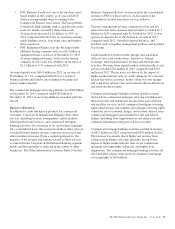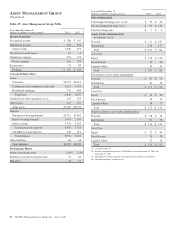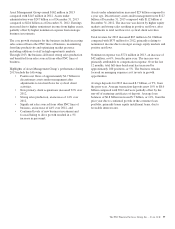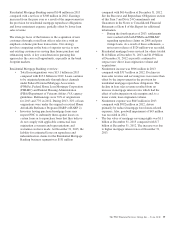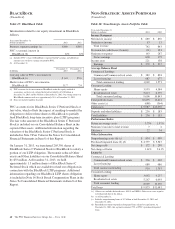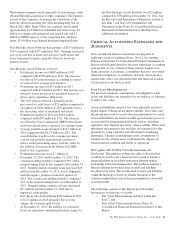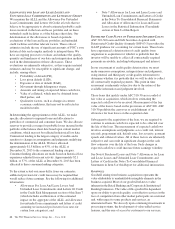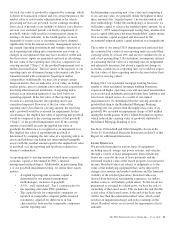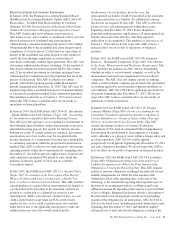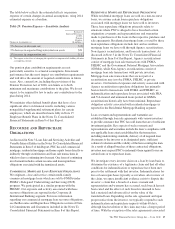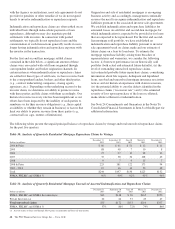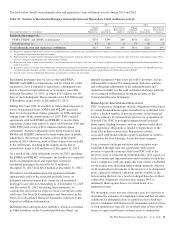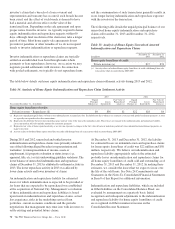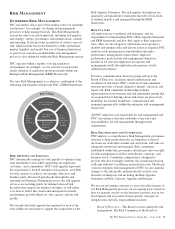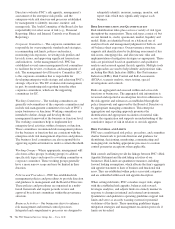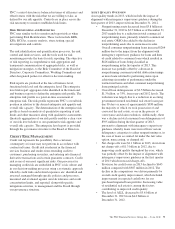PNC Bank 2013 Annual Report Download - page 83
Download and view the complete annual report
Please find page 83 of the 2013 PNC Bank annual report below. You can navigate through the pages in the report by either clicking on the pages listed below, or by using the keyword search tool below to find specific information within the annual report.R
ECENTLY
I
SSUED
A
CCOUNTING
S
TANDARDS
In January 2014, the Financial Accounting Standards Board
(FASB) issued Accounting Standards Update (ASU) 2014-04,
Receivables – Troubled Debt Restructurings by Creditors
(Subtopic 310-40): Reclassification of Residential Real Estate
Collateralized Consumer Mortgage Loans upon Foreclosure.
This ASU clarifies that an in substance repossession or
foreclosure occurs, and a creditor is considered to have received
physical possession of residential real estate property
collateralizing a consumer mortgage loan, upon (1) the creditor
obtaining legal title to the residential real estate property upon
completion of a foreclosure or (2) the borrower conveying all
interest in the residential real estate property to the creditor to
satisfy the loan through completion of a deed in lieu of
foreclosure or through a similar legal agreement. This ASU will
also require additional disclosures, including: (1) the amount of
foreclosed residential real estate property held by the creditor
and (2) the recorded investment in consumer mortgage loans
collateralized by residential real estate properties that are in the
process of foreclosure. This ASU is effective for annual
periods, and interim reporting periods within those annual
periods, beginning after December 15, 2014. This ASU may be
adopted using either a modified retrospective transition method
or a prospective transition method. Early adoption is permitted.
This guidance is effective as of January 1, 2015 and we do not
expect this ASU to have a material effect on our results of
operations or financial position.
In January 2014, the FASB issued ASU 2014-01, Investments
– Equity Method and Joint Ventures (Topic 323): Accounting
for Investments in Qualified Affordable Housing Projects.
This ASU provides guidance on accounting for investments in
flow-through limited liability entities that manage or invest in
affordable housing projects that qualify for the low-income
housing tax credit. If certain criteria are satisfied, investment
amortization, net of tax credits, may be recognized in the
income statement as a component of income taxes attributable
to continuing operations under the proportional amortization
method. This ASU is effective for annual periods, and interim
reporting periods within those annual periods, beginning after
December 15, 2014. Retrospective application is required and
early adoption is permitted. We intend to early adopt this
guidance in the first quarter of 2014 and are currently
assessing its impact.
In July 2013, the FASB issued ASU 2013-11, Income Taxes
(Topic 740): Presentation of an Unrecognized Tax Benefit
When a Net Operating Loss Carryforward, a Similar Tax
Loss, or a Tax Credit Carryforward Exists. This ASU clarifies
current guidance to require that an unrecognized tax benefit or
a portion thereof be presented in the statement of financial
position as a reduction to a deferred tax asset for a net
operating loss (NOL) carryforward, similar tax loss, or a tax
credit carryforward except when an NOL carryforward,
similar tax loss, or tax credit carryforward is not available
under the tax law of the applicable jurisdiction to settle any
additional income taxes that would result from the
disallowance of a tax position. In such a case, the
unrecognized tax benefit would be presented in the statement
of financial position as a liability. No additional recurring
disclosures are required by this ASU. This ASU is effective
for fiscal years, and interim periods within those years,
beginning after December 15, 2013. Early adoption is
permitted with prospective application to all unrecognized tax
benefits that exist at the effective date. Retrospective
application is also permitted. This guidance is effective as of
January 1, 2014 and we do not expect this ASU to have a
material effect on our results of operations or financial
position.
In June 2013, the FASB issued ASU 2013-08, Financial
Services – Investment Companies (Topic 946): Amendments
to the Scope, Measurement and Disclosure Requirement. This
ASU modifies the guidance in ASC 946 for determining
whether an entity is an investment company, as well as the
measurement and disclosure requirements for investment
companies. The ASU does not change current accounting
where a noninvestment company parent retains the specialized
accounting applied by an investment company subsidiary in
consolidation. ASU 2013-08 will be applied prospectively for
all periods beginning after December 15, 2013. We do not
expect this ASU to have a material effect on our results of
operations or financial position.
In March 2013, the FASB issued ASU 2013-05, Foreign
Currency Matters (Topic 830): Parent’s Accounting for the
Cumulative Translation Adjustment upon Derecognition of
Certain Subsidiaries or Groups of Assets within a Foreign
Entity or of an Investment in a Foreign Entity. This ASU
clarifies the timing of release of Currency Translation
Adjustments (CTA) from Accumulated Other Comprehensive
Income upon deconsolidation or derecognition of a foreign
entity, subsidiary or a group of assets within a foreign entity and
in a step acquisition. ASU 2013-05 will be applied
prospectively for all periods beginning after December 15, 2013
and early adoption is permitted. We do not expect this ASU to
have an effect on our results of operations or financial position.
In February 2013, the FASB issued ASU 2013-04, Liabilities
(Topic 405): Obligations Resulting from Joint and Several
Liability Arrangements for Which the Total Amount of the
Obligation is Fixed at the Reporting Date. This ASU requires
entities to measure obligations resulting from joint and several
liability arrangements for which the total amount of the
obligation is fixed at the reporting date, as the sum of the
following: a) the amount the reporting entity agreed to pay on
the basis of its arrangement with its co-obligors and b) any
additional amount the reporting entity expects to pay on behalf
of its co-obligors. Required disclosures include a description of
the joint and several arrangements and the total outstanding
amount of the obligation for all joint parties. ASU 2013-04 is
effective for fiscal years, and interim periods within those years,
beginning after December 15, 2013 and should be applied
retrospectively to joint and several obligations existing at the
The PNC Financial Services Group, Inc. – Form 10-K 65


